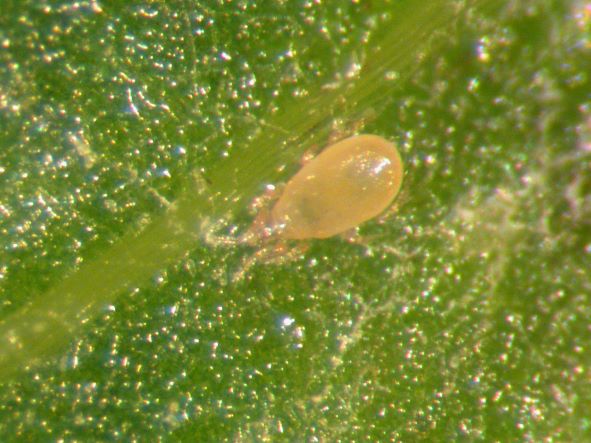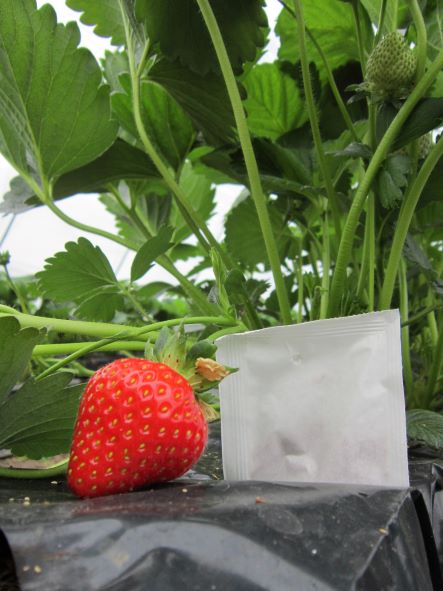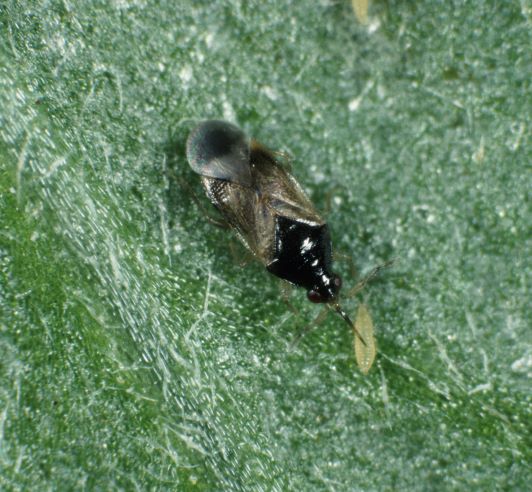Please click here to access the main AHDB website and other sectors.
- Home
- Knowledge library
- Control of tarsonemid mite on strawberry: biological
Control of tarsonemid mite on strawberry: biological
With the continuing decline of available acaricides, the ideal way to control tarsonemid mites is through biological methods.
This information was last updated in 2018.
In recent years, with the continuing decline of available acaricides to control tarsonemid mite on strawberry crops, growers have successfully gained control using the predatory mite Neoseiulus cucumeris and under glass and fixed tunnel structures, Neoseiulus californicus, or combinations of the two.
N. cucumeris is also employed to control western flower thrips (Frankliniella occidentalis) in strawberry.
Neoseiulus cucumeris
Neoseiulus cucumeris feeds on all life stages of tarsonemid mite.
It can sustain itself by feeding on pollen and is often found feeding in strawberry flowers (Figure 1).
 Bioline agrosciences
Bioline agrosciences
Figure 1. Neoseiulus cucumeris predatory mites are successfully used as biocontrol agents for tarsonemid mite.
In strawberry crops, N. cucumeris is most easily recognised under the calyx of developing fruitlets but can also be seen running over the surface of leaves.
Mobile stages are beige-pink in colour and droplet shaped.
Unlike tarsonemid mites, predatory mites are fast moving in warm conditions.
Predatory mite eggs
Predatory mite eggs are spherical in shape, white and have a shiny appearance. They can often be seen near to tarsonemid mite colonies.
Predatory mites can be introduced either through ‘slow release’ devices or by application of loose formulation.
The former is often a sachet containing breeding colonies which release individual mites continuously over several weeks.
The sachets are recommended for introduction at planting and in early spring even before flowering and before the pest is detected (Figure 2).
 RSK ADAS
RSK ADAS
Figure 2. Sachet containing Neoseiulus cucumeris offering slow release of the predators into the strawberry crop
Alternative food
At this stage, the population growth of the pest is slow and there may not be alternative food for the predatory mite.
However, it should also be noted that the emergence of N. cucumeris from sachets during cool early season conditions can be slow.
Therefore, in cool conditions, if the pest is known to be present, release of loose mites can provide higher numbers quickly onto the plants and may provide better control.
Direct sprinkling
As a loose formulation N. cucumeris is sprinkled directly into the crown of the strawberry plants for maintaining predatory mite numbers and fast establishment (Figure 3).
 RSK ADAS
RSK ADAS
Figure 3. Neoseiulus cucumeris predators being sprinkled loosely into the crowns of the strawberry crop.
Recommended introduction rates
- For prevention of thrips with cucumeris using sachet formulations, introduce around one sachet per 2.5 m2.
- Using loose formulation rates for thrips prevention, introduce 50 cucumeris per m2, doubling the rate to 100 once tarsonemid mite is detected.
- Routine introductions at fortnightly or weekly intervals depending on pest pressure and temperature should be made.
- Once an infestation of tarsonemid mite occurs, the rate should be increased to 200-400 per m2. This rate should be used on infested areas and their immediate surroundings, on the assumption that the infestation has already spread, even if damage is not yet visible.
- Repeat until the problem is under control.
- If crop damage is already occurring, it may be necessary to spray an acaricidal product then reintroduce cucumeris.
- Side-effects of applied plant protection products on cucumeris should be checked on the biocontrol suppliers web sites and reintroductions made once the persistance of the product has diminished.
- Leave the minimum necessary interval for the harmful effects of the product to decline but be aware that the rates of degradation are highly dependent on the levels of sunlight and leaf expansion.
Neoseiulus californicus
For tarsonmemid mite control under glass, the predatory mite Neoseiulus californicus, may also be released.
N.californicus is a non-native species to the UK and it is only permitted to release this predator on glasshouse-protected crops.
Under glass N. californicus is also effective at predating two-spotted spider mite (Tetranychus urticae) and is active within the temperature range of 13-35°C.
- Mobile stages look very similar to cucumeris.
- They are transparant white-orange to yellow and droplet shaped.
- Eggs are transparent to white and can be found attached to hairs along veins on the underside of leaves.
- N. californicus has recently been made available for introduction in slow release sachets and can also be applied as a loose formulation.
Recommended introduction rates
- Sachets should be deployed at one sachet per 1.2 m2 for prevention and one sachet every 1 m2 for curative control.
- Loose product should be depolyed at 25 mites per m2 for prevention and up to 200 mites per m2 for curative control.
- As with N. cucumeris, repeat applications should be made.
Changing recommendations and deployment
Commercial predatory mite production is an evolving area of pest control, with new dispensing systems and release rates being recommended as new knowledge becomes available.
Growers should keep up to date with the latest products and recommendations from suppliers.
Maximum benefits
Devices and techniques for deployment may vary but, most importantly, live biological controls should be applied to the crops as soon after delivery as possible for maximum benefits.
The recommendations from the suppliers should be read and followed for product preparation and application.
Other predatory mite species
In AHDB funded project SF 133 Optimising tarsonemid control on strawberry using predatory mites, six predatory phytoseiid mite species were evaluated for their effectiveness at controlling tarsonemid mites in one year in glasshouses.
In these experiments, N. californicus provided greater reduction of tarsonemid mites compared to Amblyseius swirskii and A. montdorensis.
Preventive control
However, A. montdorensis has successfully controlled tarsonemid mites in protected edible and ornamental crops and also predates thrips and whitefly.
In a second polytunnel test A. barkeri and N. cucumeris gave significant control compared to A. andersonii.
The former two species gave good preventive control and two releases of N. cucumeris reduced populations as a curative treatment.
A. barkeri is not currently commercially available.
Other predators
Other potential predators may include predatory flower bugs, pirate bugs (anthocorids and Orius sp. Figure 4) and predatory thrips.
However, naturally occurring predators are unlikely to completely control tarsonemid mite and regular releases of commercially available predatory mites are recommended.
Adverse effects of crop protection products
Many predators, introduced or naturally-occurring, will be affected by crop protection products and other plant health products such as vaporised sulphur.
Products applied to control spotted wing drosophila (SWD - Drosophila suzukii) are likely to have residual effects on introduced predatory mites, so reintroductions need to be timed appropriately following spray applications targeted to control SWD.
 Nigel Cattlin
Nigel Cattlin
Figure 4. Pirate bugs such as Orius may offer some control of tarsonemid mite, but this cannot be relied upon to gain complete control
Useful links
Find more resources on strawberry
Biocontrol in Soft Fruit Guide
Tarsonemid mite on strawberry: Crop damage
Tarsonemid mite on strawberry: Identification, spread and monitoring
Control of tarsonemid mite on strawberry: clean planting material
Control of tarsonemid mite on strawberry: cultural
Control of tarsonemid mite on strawberry: chemical
Read about side effects of crop protection products on biological control:
Author/s
The content for these web pages was authored for AHDB by Michelle Fountain and Jerry Cross (NIAB).
Topics:
Sectors:
Tags:

